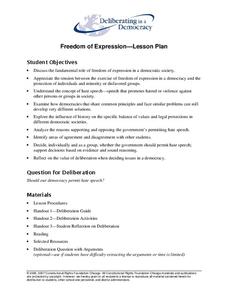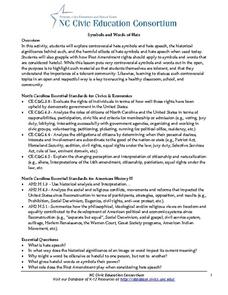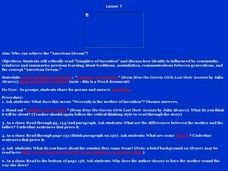Deliberating in a Democracy
Freedom of Expression
Should democracies include hate speech as a protected right? Scholars analyze the rights found under the First Amendment to the Constitution through researching evidence. Freedom of expression becomes the focal point of the...
University of North Carolina
Symbols and Words of Hate
This resource is structured with exercises that ask class members to explore hate symbols and hate speech. Learners examine the historical significance and harmful effects of these words and symbols, examine the First Amendment and...
Curated OER
Hate 2.0
Combat hate online by bringing it into the light. Begin by giving learners a quiz, then lead a discussion based on the issues the quiz brought up. As a class, develop strategies to confront online hate. Assign different venues to groups...
Curated OER
Free Speech or Hate Speech?
High schoolers see the difference between protected and prohibited speech as guaranteed by the First Amendment. They explain why free speech is essential to a democracy and consider how best to deal with speech they find offensive.
Curated OER
Freedom of Hate Speech?
Young scholars, using a New York Times article as a springboard for discussion, investigate and debate the complex issues of First Amendments Rights and censorship for Hate Groups using Websites for propaganda.
Curated OER
A Safe Place For Hate?
Students explore the conflict over the admission of hate-related information onto web portals and other web sites, and, after representing the point-of-view of the constituencies involved in this conflict, posit possible solutions to the...
Curated OER
Should Hate Be Outlawed?
Students investigate hate crime legislation. In this hate crime lesson, students examine the St. Paul city ordinance that outlawed hate crimes. Students explore the fine between hate crime legislation and First Amendment rights.
Curated OER
The Power of Words Anti-Semitism and Hate Speech
Students investigate words associated with Anti-Semitism and hate. They view and discuss a video about teaching tolerance focusing on language usage.
Administrative Office of the US Courts
Snyder v. Phelps
Does the Westboro Baptist Church have the protection of the Constitution when protesting military funerals? High schoolers examine the 2011 Supreme Court case of Snyder v. Phelps before comparing the situation to a fictional...
Echoes & Reflections
Antisemitism
Propaganda and anti-semitism were linked to evil ends during the Holocaust. Using video testimony of Holocaust survivors, examples of Nazi propaganda, and discussion questions, learners explore the roots of anti-semitism in Europe and...
Curated OER
The Holocaust's Legacy
High schoolers investigate contemporary hate groups and then participate in a debate on tolerating their existence of the Holocaust. They work in groups to conduct research. Students use print and Web resources to identify one or more...
Curated OER
People are People
Explore human diversity in this human rights lesson. Middle schoolers compare novels, speeches, videos, and short stories that promote diversity and basic human rights. They complete daily coursework as they read the selected literature...
Adult Fiction by Jewell Parker Rhodes
Ghost Boys: Educator Guide
The spirit of the Civil Rights Movement lives on in a more literal than figurative way in Ghost Boys. A focused lesson plan features Jewell Parker Rhodes' novel about ghosts of slain black teenagers, including the main character, Jerome,...
Curated OER
Thanksgiving Day Activities Stative Verb Review
In this Thanksgiving verb review worksheet, students mark an X on the incorrect forms of the verbs. They write the correct form above each incorrect verb. There are 10 questions on this page.
Curated OER
The Armenian Genocide: The American Ambassador in Constantinople
High schoolers analyze America's reaction to the Armenian Genocide. They write a journal response, read and discuss text, compare/contrast reactions around the world to the Armenian Genocide and the genocide in Rwanda, and write an essay.
Curated OER
Lesson: Text Messages
Can a neon sign be considered art? Kids consider two different works that use neon text as the basis for conveying artistic social messages. They then analyze a truism from Jenny Holzer's web site that holds meaning to them personally....
Student Handouts
Examining Primary Sources: Rudyard Kipling, “The White Man’s Burden” (1899)
Combine literature and history with the poem "The White Man's Burden" by Rudyard Kipling. Pupils read the poem and answer four questions about the text.
Curated OER
The Bill of Rights - The First Ten Amendments to the Constitution
The Bill of Rights, and the First Ten Ammendments to the Constitution are the focus of this Social Studies presentation. Students view a presentation that nicely presents, not only what each Ammendment says, but examples of how they...
Curated OER
Who Can Achieve the "American Dream"
Exploring the idea of working to achieve the American Dream, the class reads an excerpt from How the Garcia Girls Lost their Accents by Julia Alvarez. Following, the class analyzes the excerpt and discusses the theme of the reading using...
Student Handouts
Letter from Birmingham Jail
Analyze an abridged version of Martin Luther King Jr's "Letter from Birmingham Jail." Class members read the excerpt and respond to four provided questions, which focus on the content provided. Consider taking the time to read the entire...
Curated OER
Quotations of Martin Luther King, Jr.
In this quotations worksheet, students read and analyze 7 quotations by Martin Luther King, Jr. Students match each quote to the correct interpretation.
Curated OER
Martin Luther King, Jr.
In this Martin Luther King worksheet, students read a passage about King. They then answer six multiple choice recall questions about the story.
Curated OER
The Civil War
Young scholars are able to describe all of the Civil War terms. They are able to wonder why things happened. Students are able to tell that the United States used to be two countries.
Curated OER
Cartoons for the Classroom: A Racist Tirade Spotlights the N-Word
In this current events worksheet, students analyze a political cartoon about racial epithets and respond to 3 talking point questions.























